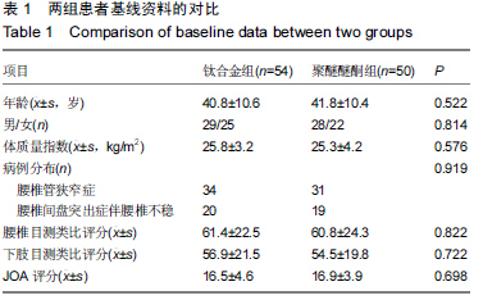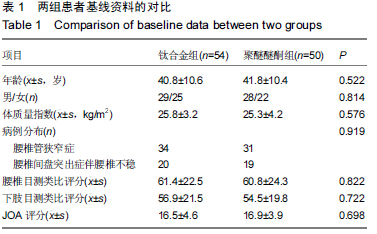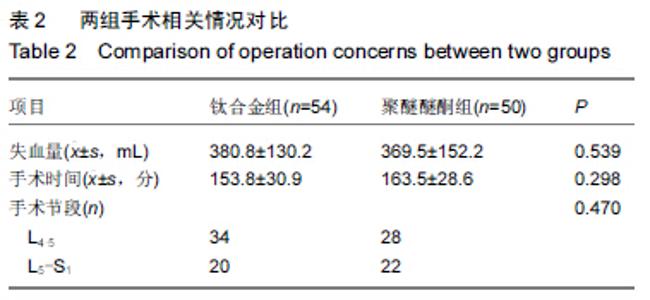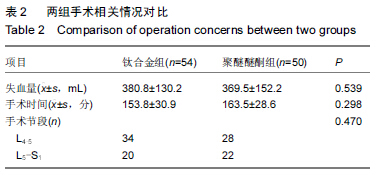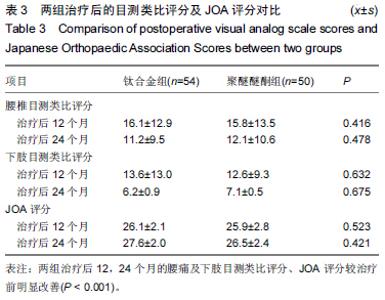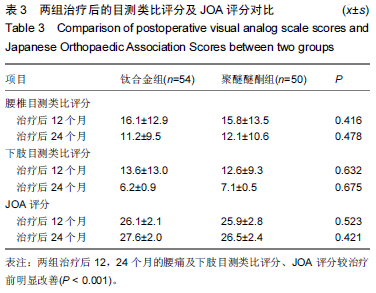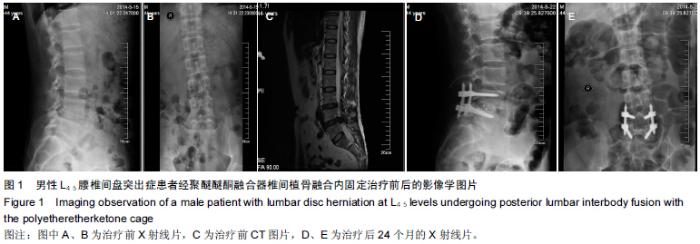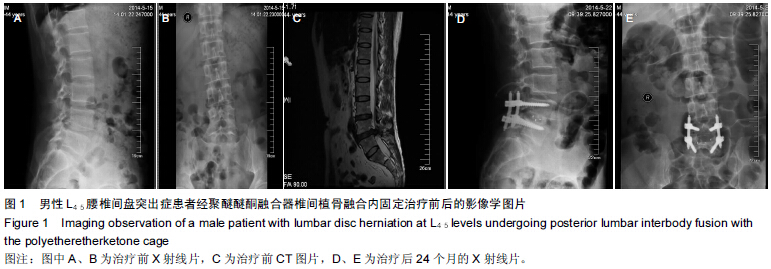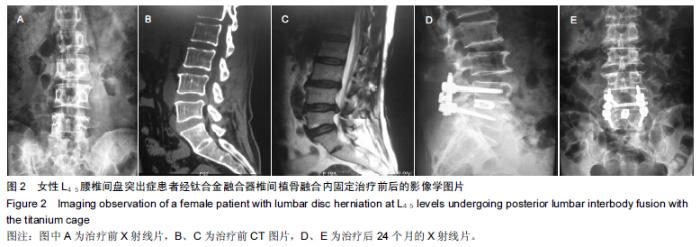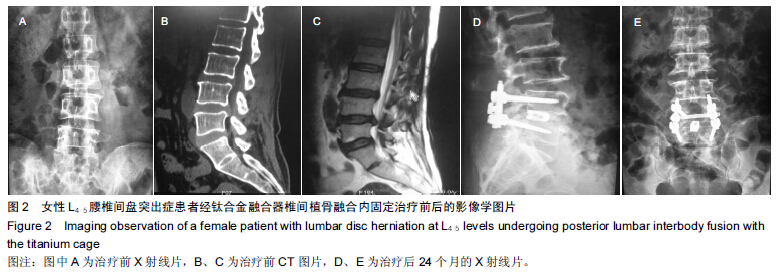Chinese Journal of Tissue Engineering Research ›› 2015, Vol. 19 ›› Issue (43): 6953-6957.doi: 10.3969/j.issn.2095-4344.2015.43.012
Previous Articles Next Articles
Titanium cage versus polyetheretherketone cage in posterior lumbar interbody fusion with pedicle screw fixation
Liu Rui-duan1, Xiao Rong-chi1, Tang Zhi-hong1, Jin An-min2
- 1Affiliated Hospital of Guilin Medical University, Guilin 541001, Guangxi Zhuang Autonomous Region, China; 2Zhujiang Hospital of Southern Medical University, Guangzhou 510515, Guangdong Province, China
-
Received:2015-07-24Online:2015-10-15Published:2015-10-15 -
Contact:Xiao Rong-chi, Professor, Affiliated Hospital of Guilin Medical University, Guilin 541001, Guangxi Zhuang Autonomous Region, China -
About author:Liu Rui-duan, Studying for doctorate, Attending physician, Affiliated Hospital of Guilin Medical University, Guilin 541001, Guangxi Zhuang Autonomous Region, China -
Supported by:the Scientific Research and Plan Development Project of Guilin City, No. 20140120-1-14
Cite this article
Liu Rui-duan, Xiao Rong-chi, Tang Zhi-hong, Jin An-min. Titanium cage versus polyetheretherketone cage in posterior lumbar interbody fusion with pedicle screw fixation[J]. Chinese Journal of Tissue Engineering Research, 2015, 19(43): 6953-6957.
share this article
|
[1] Brantigan JW,Steffee AD,Lewis ML,et al.Lumbar interbody fusion using the Brantigan I/F cage for posterior lumbar interbody fusion and the variable pedicle screw placement system: two-year results from a Food and Drug Administration investigational device exemption clinical trial.Spine (Phila Pa 1976).2000;25:1437-1446.
[2] Hashimoto T,Shigenobu K,Kanayama M,et al.Clinical results of single level posterior lumbar interbody fusion using the Brantigan I/F carbon cage filled with a mixture of local morselized bone and bioactive ceramic granules.Spine (Phila Pa 1976). 2002;27:258-262.
[3] Galbusera F,Bellini CM,Anasetti F,et al. Rigid and flexible spinal stabilization devices: A biomechanical comparison.Med Eng Phys.2011;33:490-496.
[4] Smit TH,Muller R,van Dijk M,et al.Changes in bone architecture during spinal fusion: Three years follow-up and the role of cage stiffness.Spine (Phila Pa 1976). 2003;28: 1802-1808, discussion 1809.
[5] Vadapalli S,Sairyo K,Goel VK,et al.Biomechanical rationale for using polyetheretherketone spacers for lumbar interbody fusion-a finite element study. Spine (Phila Pa 1976).2006; 31:992-998.
[6] Lee JH,Lee JH,Park JW,et al.Fusion rates of a morselized local bone graft in polyetheretherketone cages in posterior lumbar interbody fusion by quantitative analysis using consecutive three-dimensional computed tomography scans. Spine J.2011;11:647-653.
[7] Schimmel JJP,Poeschmann MS,Horsting PP,et al.PEEK cages in lumbar fusion:mid-term clinical outcome and radiological fusion.J Spinal Disord Tech.2012.[Epub ahead of print]doi: 10.1097/BSD.0b013e31826eaf74.
[8] Chen Y,Wang X,Lu X,et al.Comparison of titanium and polyetheretherketone (PEEK) cages in the surgical treatment of multilevel cervical spondylotic myelopathy: a prospective, randomized, control study with over 7-year follow-up.Eur Spine J.2013;22(7):1539-1546.
[9] Navarrete RO,Gittens RA,Schneider JM,et al.Osteoblasts exhibit a more differentiated phenotype and increased bone morphogenetic protein production on titanium alloy substrates than on poly-ether-ether-ketone. Spine J. 2012;12:265-272.
[10] Kurtz SM,Devine JN.PEEK biomaterials in trauma, orthopedic, and spinal implants.Biomaterials.2007;28:4845-4869.
[11] Brantigan JW,Steffee AD,Lewis ML,et al.Lumbar interbody fusion using the Brantigan I/F cage for posterior lumbar interbody fusion and the variable pedicle screw placement system. Spine (Phila Pa 1976).2000;25:1437-1446.
[12] Cook SD,Patron LP,Christakis PM,et al.Comparison of methods for determining the presence and extent of anterior lumbar interbody fusion. Spine (Phila Pa 1976).2004;29: 118-123.
[13] Cutler AR,Siddiqui S,Mohan AL,et al.Comparison of polyetheretherketone cages with femoral cortical bone allograft as a single-piece interbody spacer in transforaminal lumbar interbody fusion.J Neurosurg Spine.2006;5:534-539.
[14] Kraiwattanapong C,Boden SD,Louis-Ugbo J,et al.Comparison of Healos/bone marrow to INFUSE(rhBMP-2/ACS) with a collagenceramic sponge bulking agent as graft substitutes for lumbar spine fusion.Spine. 2005;30:1001-7; discussion 7.
[15] Rihn JA, Kirkpatrick K, Albert TJ. Graft options in posterolateral and posterior interbody lumbar fusion.Spine (Phila Pa 1976).2010;35:1629-1639.
[16] Tokuhashi Y,Ajiro Y,Umezawa N.Subsidence of metal interbody cage after posterior lumbar interbody fusion with pedicle screw fixation.Orthopedics.2009;32:32-34.
[17] Helgeson md,Lehman RA,Patzkowski JC,et al.Adjacent vertebral body osteolysis with bone morphologic protein use in transforaminal lumbar interbody fusion.Spine J.2011;11(6): 507-510.
[18] Choi JY,Sung KH.Subsidence after anterior lumbar interbody fusion using paired stand-alone rectangular cages.Eur Spine J.2006;15:16-22.
[19] Kim MC,Chung HT,Cho JL,et al.Subsidence of Polyetheretherketone Cage After Minimally Invasive Transforaminal Lumbar Interbody Fusion.J Spinal Disord Tech. 2013;26(2):87-92.
[20] Nemoto O,Asazuma T,Yato Y,et al.Comparison of fusion rates following transforaminal lumbar interbody fusion using polyetheretherketone cages or titanium cages with transpedicular instrumentation.Eur Spine J. 2014;23(10): 2150-2155.
[21] Ha SK,Park JY,Kim SH,et al.Radiologic assessment of subsidence in stand-alone cervical polyetheretherketone (PEEK) cage. J Korean Neurosurg Soc.2008;44:370-374.
[22] Beutler WJ,Peppelman WC Jr.Anterior lumbar fusion with paired BAK standard and paired BAK Proximity cages: subsidence incidence, subsidence factors, and clinical outcome. Spine J.2003;3:289-293. |
| [1] | Zhang Tongtong, Wang Zhonghua, Wen Jie, Song Yuxin, Liu Lin. Application of three-dimensional printing model in surgical resection and reconstruction of cervical tumor [J]. Chinese Journal of Tissue Engineering Research, 2021, 25(9): 1335-1339. |
| [2] | Zeng Yanhua, Hao Yanlei. In vitro culture and purification of Schwann cells: a systematic review [J]. Chinese Journal of Tissue Engineering Research, 2021, 25(7): 1135-1141. |
| [3] | Song Chengjie, Chang Hengrui, Shi Mingxin, Meng Xianzhong. Research progress in biomechanical stability of lateral lumbar interbody fusion [J]. Chinese Journal of Tissue Engineering Research, 2021, 25(6): 923-928. |
| [4] | Xu Dongzi, Zhang Ting, Ouyang Zhaolian. The global competitive situation of cardiac tissue engineering based on patent analysis [J]. Chinese Journal of Tissue Engineering Research, 2021, 25(5): 807-812. |
| [5] | Wu Zijian, Hu Zhaoduan, Xie Youqiong, Wang Feng, Li Jia, Li Bocun, Cai Guowei, Peng Rui. Three-dimensional printing technology and bone tissue engineering research: literature metrology and visual analysis of research hotspots [J]. Chinese Journal of Tissue Engineering Research, 2021, 25(4): 564-569. |
| [6] | Chang Wenliao, Zhao Jie, Sun Xiaoliang, Wang Kun, Wu Guofeng, Zhou Jian, Li Shuxiang, Sun Han. Material selection, theoretical design and biomimetic function of artificial periosteum [J]. Chinese Journal of Tissue Engineering Research, 2021, 25(4): 600-606. |
| [7] | Liu Fei, Cui Yutao, Liu He. Advantages and problems of local antibiotic delivery system in the treatment of osteomyelitis [J]. Chinese Journal of Tissue Engineering Research, 2021, 25(4): 614-620. |
| [8] | Li Xiaozhuang, Duan Hao, Wang Weizhou, Tang Zhihong, Wang Yanghao, He Fei. Application of bone tissue engineering materials in the treatment of bone defect diseases in vivo [J]. Chinese Journal of Tissue Engineering Research, 2021, 25(4): 626-631. |
| [9] | Zhang Zhenkun, Li Zhe, Li Ya, Wang Yingying, Wang Yaping, Zhou Xinkui, Ma Shanshan, Guan Fangxia. Application of alginate based hydrogels/dressings in wound healing: sustained, dynamic and sequential release [J]. Chinese Journal of Tissue Engineering Research, 2021, 25(4): 638-643. |
| [10] | Chen Jiana, Qiu Yanling, Nie Minhai, Liu Xuqian. Tissue engineering scaffolds in repairing oral and maxillofacial soft tissue defects [J]. Chinese Journal of Tissue Engineering Research, 2021, 25(4): 644-650. |
| [11] | Xing Hao, Zhang Yonghong, Wang Dong. Advantages and disadvantages of repairing large-segment bone defect [J]. Chinese Journal of Tissue Engineering Research, 2021, 25(3): 426-430. |
| [12] | Tang Xiaokai, Li Weiming. Role and mechanism of Nel-like molecule-1 in promoting bone fusion after spinal fusion [J]. Chinese Journal of Tissue Engineering Research, 2021, 25(24): 3914-3920. |
| [13] | Yang Qin, Zhou Honghai, Chen Longhao, Zhong Zhong, Xu Yigao, Huang Zhaozhi. Research status and development trend of pelvic reconstruction techniques: a bibliometric and visual analysis [J]. Chinese Journal of Tissue Engineering Research, 2021, 25(23): 3718-3724. |
| [14] | Chen Siqi, Xian Debin, Xu Rongsheng, Qin Zhongjie, Zhang Lei, Xia Delin. Effects of bone marrow mesenchymal stem cells and human umbilical vein endothelial cells combined with hydroxyapatite-tricalcium phosphate scaffolds on early angiogenesis in skull defect repair in rats [J]. Chinese Journal of Tissue Engineering Research, 2021, 25(22): 3458-3465. |
| [15] | Wang Hao, Chen Mingxue, Li Junkang, Luo Xujiang, Peng Liqing, Li Huo, Huang Bo, Tian Guangzhao, Liu Shuyun, Sui Xiang, Huang Jingxiang, Guo Quanyi, Lu Xiaobo. Decellularized porcine skin matrix for tissue-engineered meniscus scaffold [J]. Chinese Journal of Tissue Engineering Research, 2021, 25(22): 3473-3478. |
| Viewed | ||||||
|
Full text |
|
|||||
|
Abstract |
|
|||||
